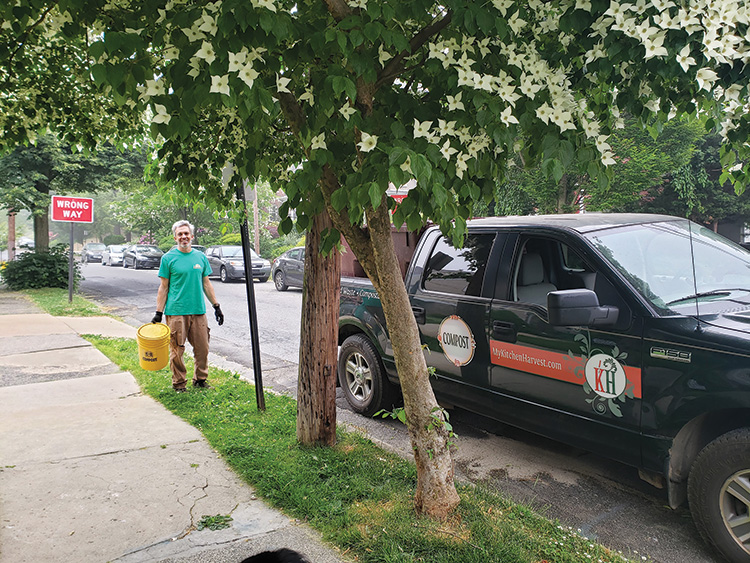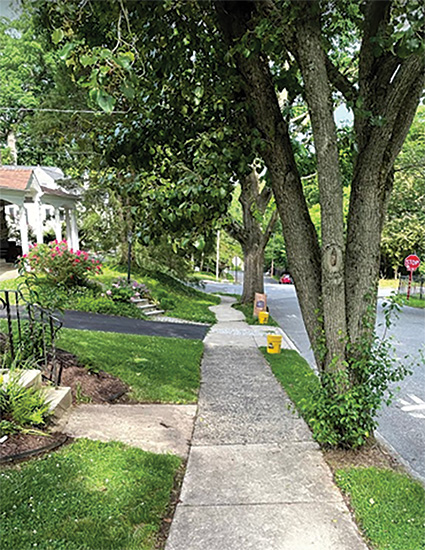Curbside food waste collection helps put communities on a path to high waste material diversion while providing a high level of service to residents, and lowering a community’s carbon footprint.
By Brent Dieleman
An increasing number of communities are evaluating and implementing curbside food waste collection programs. For those contemplating or just starting such a program, there are several considerations to take into account. This article provides guidance on what to consider for communities either exploring or launching a curbside food waste collection program.


Seasonal Implementation
The time of year, when you start a food waste collection program, can be key to participation. Depending on your location, launching the program during spring or fall is typically a better option than during the temperature and weather extremes that can come with winter or summer. Initiating the program in the summer when insects and other vectors are active can discourage residents from getting involved due to the “yuck” factor.
Municipalities that start curbside food waste collection programs in the winter can also run into operational issues that dampen participation. For example, the Borough of State College, PA, launched its pilot program in January. The Borough discovered that participation was less than expected because residents were less active outdoors during the winter. They also found delivering food waste containers to residences particularly challenging during winter weather. Furthermore, the Borough found that providing residents with additional containers for food waste in the winter and asking them to store and use them was viewed as a burden.
Other communities have noted that loose food waste in curbside containers froze to the side of the containers, making collection difficult. For this reason, some communities provide compostable bags and encourage residents to keep food waste in the bags, especially during the winter.
Gradual Participation
Residents are often reluctant to participate in food waste collection programs because they find separating food waste from other household trash distasteful and time-consuming. Overcoming this obstacle is key to increasing participation in food waste diversion programs. Municipalities that have implemented curbside food waste collection programs can find success in encouraging gradual participation by reluctant residents. For example, residents can be encouraged to participate by placing soiled napkins and paper towels in food collection containers (assuming the local composting facility accepts those materials). Once they become accustomed to that limited practice, with minimum undesirable consequences, they often can be encouraged to start placing some food items, such as apple cores and banana peels, in the container.
Over time, residents can be encouraged to gradually ramp up their participation until they are comfortable diverting all kinds of food waste. This practice of gradual participation can attract residents who may not initially be ready to jump right into diverting all their food waste.
Use of Bags
The use of compostable bags in food waste collection programs varies nationwide. Some municipalities, including Takoma Park, MD and Princeton, NJ provide a continual supply of compostable bags for residents to line their containers. Arlington County, VA provided residents with an initial supply of compostable bags when their program started, but now requires residents to purchase additional compostable bags if desired. The City of South Portland, ME does not provide bags to residents, but accepts food waste contained in resident-supplied compostable bags. State College, PA, and the towns of Hamilton and Wenham, MA, accept compostable bags with food waste, but do not encourage their use.
Providing compostable bags to residents increases curbside food waste collection program costs. However, compostable bags encourage more residents to participate in the program since the bags minimize odors and keep containers clean. Communities considering using these bags should talk to the facility processing the material to confirm that the bags are acceptable.
If bags are to be part of a program, educate residents on what types of bags are acceptable for use. It is also important to note that there is a difference between compostable and biodegradable bag labeling, which can create confusion among residents. If compostable bags are unacceptable, the community may encourage residents to use unlined paper bags or newspapers to contain food waste.

Containers
No one container type or size is associated with the success of curbside food waste collection programs. Some municipalities provide two containers for residents to use. One container is smaller for kitchens, while the other is a larger cart for curbside collection. Other municipalities provide only one container (typically a five- or six-gallon bucket) for residents to place curbside.
A major factor impacting the choice of container type is whether food waste will be collected using a manual or automated system. Cart-based programs are typically associated with automated collection. Some municipalities that provide carts will co-collect food waste with yard waste. Municipalities that provide kitchen pails report that some households use other containers (e.g., repurposed coffee containers) to collect food waste.
The City of Takoma Park, MD does not supply kitchen pails because they do not provide residents with garbage cans or recycling containers. Not providing kitchen containers may be one way a community can reduce costs. On the other hand, providing containers may make it more convenient for residents to participate. Regardless of the type or size of container selected for a program, we recommend that it come with a tight-fitting lid to minimize nuisance concerns.
User Fees
Communities with municipal curbside food waste collection programs typically do not charge a separate user fee to participate. The cost of food waste collection is often included in the solid waste or refuse fee that residents pay whether they choose to participate in the program or not (which is often consistent with handling recycling costs). A separate user fee will discourage participation and likely cause the program to be underused. If not charging a direct food waste collection fee, a community needs to plan for and allocate adequate resources to cover the program costs over the long term.
Closing the Loop
One element of a successful food waste management program is having a market for finished compost. Two common ways that communities can help establish a compost market include:
1. Providing finished compost to residents encourages participation in the food waste program. A community may give residents that participate a discount or offer compost products free of charge, rewarding residents for participating and helping close the loop in making the program successful.
2. Requiring the use of compost in community projects helps local governments and communities establish internal policies that require the use of compost in community and park landscaping projects. These policies help facilitate the use of the compost product and demonstrate to residents the value of the product.
Education
The amount of time and effort a community spends educating residents about its curbside food waste collection program ties directly to its success. Municipalities with successful food waste collection programs conduct extensive education and outreach efforts in their respective programs’ planning and implementation phases. These educational initiatives use various methods (social media, printed information brochures, in-person communication) to provide information about curbside food waste collection programs. Communities evaluating curbside food waste collection should allow ample time to educate the public before and after launching the program.
Establishing a Pilot Program
Most municipalities implementing curbside food waste collection complete a pilot program to collect data on program participation, diversion impacts, costs, material quantities, contamination, and community concerns. This information serves to inform decisions about program expansion and improvement.
Conducting Surveys
Surveying participants about their experiences with a curbside food waste collection program is valuable for getting feedback. The community may choose between a formal, comprehensive survey process or surveying participants informally in a more ad-hoc fashion. We recommend that a community maintain open communication with residents throughout the pilot program and provide them with an ongoing opportunity to provide feedback.
Close to the pilot’s conclusion, a community should consider a formal survey to receive feedback on all aspects of the program. The survey provides a mechanism for obtaining more formal results that can be tabulated and presented to interested stakeholders.
Exploring Outside Funding
Funding may be available from local, state, and non-profit sources to pay for various aspects of a curbside food waste collection program, particularly for collection containers. Communities should research and identify outside funding sources to pay for part of their program. For example, in 2022, USDA invested $10.2 million in new Composting and Food Waste Reduction (CFWR) cooperative agreements. In 2020, the City of Fayetteville, AR, received grant funds to purchase a mobile food waste collection trailer and fund an education position. The program also provided residents with a 3.5-gallon home food waste container.
Evaluating Environmental Benefits
While providing curbside food waste collection provides convenience for residents to divert these materials from disposal, it is important to consider the full environmental impacts of the program. Unless mandated, participation in a curbside food waste collection program is likely to be low, at least initially. While there are environmental and emission benefits from diverting food waste from disposal, those benefits can quickly be overcome by having to route a truck throughout the community to pick up food waste from the small fraction of participating residents. A community that completes a full greenhouse gas assessment of a curbside program can quantify the program’s environmental impact. A full-service environmental engineering firm can provide one incorporated into your program plan. The results help encourage more residents to make a difference.
Implementing a curbside food waste collection program takes time and resources. Many aspects of the program are evaluated and considered so that a community can implement a program that works for them, sustainably. Curbside food waste collection helps put communities on a path to high waste material diversion while providing a high level of service to residents, lowering a community’s carbon footprint. | WA
Brent Dieleman is Project Manager for SCS Engineers Sustainable Materials Management Practice. He is a certified TRUE Advisor with two decades of solid waste planning experience, including managing and directing waste characterization studies globally. He can be reached at [email protected]
